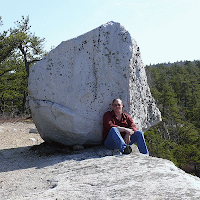 Most of us have a lot of stress in our daily lives. The word "stress" is used in geology too, but in a bit of a different way. In geology stress is defined as an average force (F) per unit area (A) and is abbreviated by the lower-case Greek letter sigma. Mathematically it's σ = F/A.
Most of us have a lot of stress in our daily lives. The word "stress" is used in geology too, but in a bit of a different way. In geology stress is defined as an average force (F) per unit area (A) and is abbreviated by the lower-case Greek letter sigma. Mathematically it's σ = F/A.Why is it a force per unit area? I tell my students to think of it this way. Imagine a 50 kg woman (110 lbs) standing on your bare foot. She's wearing those fashionable shoes to the right. Would you rather she stand on your foot with the stiletto heel or with the flat part of the shoe where her toes are? Why? It's all the same force (50 kg). Well, obviously, the cross sectional area in contact with your foot is important.
A unit of stress most people are familiar with is pounds per square inch (lbs/in2 or psi). In geology, however, we use the SI unit pascal (Pa) named after the French mathematician Blaise Pascal (1623-1662). A pascal is a small unit equal to only 1.450377 x 10-4 psi and is defined as 1 newton (N) of force per square meter (m2) of surface area. In geology, where we deal with stresses associated with plate tectonics and mountain building, the unit megapascals (MPa or 1,000,000 Pa) is routinely used.
How much stress to crumple up these mountains?
As an aside... Don't confuse stress with pressure which use the same units. The atmospheric pressure, for example is 14.7 psi and you might inflate your car tires to 30 psi. What's the difference between that and someone standing on your foot exerting a stress of 100 lbs/in2? The difference is that pressure is a scalar (non-directional) quantity and stress is a vector (directional) quantity. In other words, pressure is the same in all directions (sometimes called a confining stress) while stress is directed. We represent stress as an arrow - it has a magnitude and a direction.
 In geology, we often talk about different kinds of stress. In the diagrams at left we see examples of tensile stress (a pulling apart), compressive stress (a squeezing), and shear stress (side-to-side movement). The arrows, of course, denote the force directions. These types of stresses are what make rocks deform (change size, shape, position, and/or orientation). By the way, it's not just geology, engineers talk about stresses in concrete pillars and steel I-beams instead of rocks (rocks are actually harder to analyze because they vary so much unlike engineered materials).
In geology, we often talk about different kinds of stress. In the diagrams at left we see examples of tensile stress (a pulling apart), compressive stress (a squeezing), and shear stress (side-to-side movement). The arrows, of course, denote the force directions. These types of stresses are what make rocks deform (change size, shape, position, and/or orientation). By the way, it's not just geology, engineers talk about stresses in concrete pillars and steel I-beams instead of rocks (rocks are actually harder to analyze because they vary so much unlike engineered materials). Of course it's a bit more complicated in that we're looking at very simple examples and a better analysis is done of stress in a three-dimensional stress field. In more advanced structural geology (the branch of geology dealing with rock deformation), we talk about the stress ellipsoid where the stress field around a point can be broken down into three principal stress axes (σ1, σ2, and σ3).
Of course it's a bit more complicated in that we're looking at very simple examples and a better analysis is done of stress in a three-dimensional stress field. In more advanced structural geology (the branch of geology dealing with rock deformation), we talk about the stress ellipsoid where the stress field around a point can be broken down into three principal stress axes (σ1, σ2, and σ3).By the way, the stress ellipsoid would be a sphere if all directions were equal as in a case of pressure.
Think in terms of large-scale plate tectonic movements. Tensile stresses are associated with the rifting apart of continents like the modern-day East African Rift Valley, for example. Compressive stresses are associated with collisional events like India colliding with Asia to crumple up the Himalaya. Shear stresses are associated with plate boundaries sliding sideways past each other like the San Andreas fault boundary in California separating the North America and Pacific Plates (hypothetical example shown below).
Next time I'll talk about the relationship between stress and strain in geology.





No comments:
Post a Comment